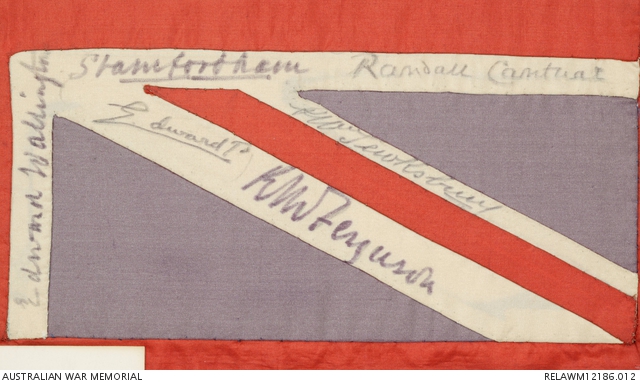| Place | Oceania: Australia, Victoria, Melbourne |
|---|---|
| Accession Number | RELAWM12186.012 |
| Collection type | Heraldry |
| Object type | Flag |
| Physical description | Silk |
| Location | Main Bld: First World War Gallery: Western Front 1916: Homefront |
| Maker |
Unknown |
| Place made | Australia |
| Date made | c 1915 |
| Conflict |
First World War, 1914-1918 |
'The Kitchener Flag' : Australian red ensign autographed and raffled for the benefit of wounded Australian soldiers














Silk, handmade, Australian red ensign. The stars and Union Jack are also handmade and have been appliquéd to the flag. A square of white silk has been attached to the flag, signed in indelible pencil 'George R.I. Mary R', as well as a visiting card, placed under the Union Jack, marked 'THE WHITE HOUSE WASHINGTON' and signed in ink 'Woodrow Wilson'. The large Federation star is signed in pencil 'J.Foch', the smaller stars, in black ink or pencil 'D.Haig', 'David Beatty', 'J.Joffre', 'W R Robertson' and 'Jellicoe'. The white stripes of the Union Jack have been signed 'Rudyard Kipling', 'H.H. Asquith', 'Devonshire', 'J.P. Morgan', 'A. Bonar Law', 'D Lloyd George', 'John Monash', 'E. Grey', 'Derby', 'Roseberry', 'Beresford', 'Kitchener', 'W. Birdwood', 'W.M. Hughes', 'Randall Cantuar', 'W Tewkesbury', 'R.W. Ferguson', 'Edward Wallington', 'Edward P', 'Stamfordham' and 'Beresford'. The signatures on the flag are those of : The Duke of Devonshire, Governor-General of Canada 1916-1921; Mr Rudyard Kipling, Author and Nobel Prize winner for literature 1907; The Right Honourable Andrew Bonar Law, Secretary of State for the Colonies 1916-1921; Sir Edward Grey (Viscount Grey), Secretary of State for Foreign Affairs 1905-1916; Lord Rosebery, Prime Minister of Great Britain 1894-1895; The Honourable William Morris Hughes, Prime Minister of Australia 1915-1922; Earl Kitchener of Khartoum and Broome, Secretary of State for War 1914-1916; Lord Birdwood of ANZAC and Totnes, Commander of the Australian Imperial Forces 1914-1919; Lord Stamfordham, Private Secretary to King George V 1910-1931; Sir Ronald Munro Ferguson, Governor-General of Australia 1914-1920; The Honourable Herbert Henry Asquith, Prime Minister of Great Britain 1908-1916; Mr John Pierpont Morgan II, Industrialist said to be one of the world's richest men; The Right Honourable David Lloyd George, Prime Minister of Great Britain 1916-1922; Lord Derby, Secretary of State for War1916-1918; The Right Honourable Arthur James Balfour, First Lord of the Admiralty 1915-1916; Admiral Lord Charles Beresford, Commander of the Channel Fleet 1907-1909; Sir Edward Wallington, Private Secretary to Queen Mary 1910-1919; The Most Reverend Randall Davidson, Archbishop of Canterbury 1903-1928; Marshal Joseph Joffre, Commander-in-Chief of the French Armies 1915-1917; Earl Haig of Bemersyde, Commander-in-Chief of British forces 1915-1919; Field Marshal Sir William Robertson, Chief of the Imperial General Staff 1916-1918; Viscount Jellicoe of Scapa, Commander of the Grand Fleet 1914-1916; His Majesty King George V , King of England 1910-1936; Her Majesty Queen Mary, Wife of the King of England 1910-1936; Edward Windsor, Prince of Wales, later King of England (Edward VIII); President Woodrow Wilson, President of the United States of America 1912-1920; Marshal Ferdinand Foch, Commander of Allied forces Western Front 1918; General Sir John Monash, Commander of the Australian Corps in France 1918; Admiral Sir David Beatty, Commander of the Grand Fleet 1914-1919; Mr William Tewksbury, Originator of the concept for the 'Kitchener Flag' .
Pearson William Tewksbury, a successful Melbourne businessman, conceived the idea of raising funds for wounded Australian soldiers by raffling a flag autographed by the world's most famous men, including national and war leaders, Field Marshal Lord Kitchener, Prime Minister W M Hughes and General Monash. The flag was sent around the world to obtain the signatures and 30,000 pounds was raised from the raffle. The flag was advertised as the 'Kitchener Flag'. It was won in 1918 by a retired seaman who sold it for 2000 guineas to Edward 'Teddy' Solomon, a Melbourne philanthropist and collector, who had already purchased other autographed flags at fund raising auctions for the war effort. Solomon later presented his entire autographed flag collection, which he had acquired during the First World War, to the Australian War Memorial. During the Second World War Tewkesbury again raised funds for wounded soldiers by raffling an autographed flag known as the 'Churchill Flag', this time raising 28,000 pounds.